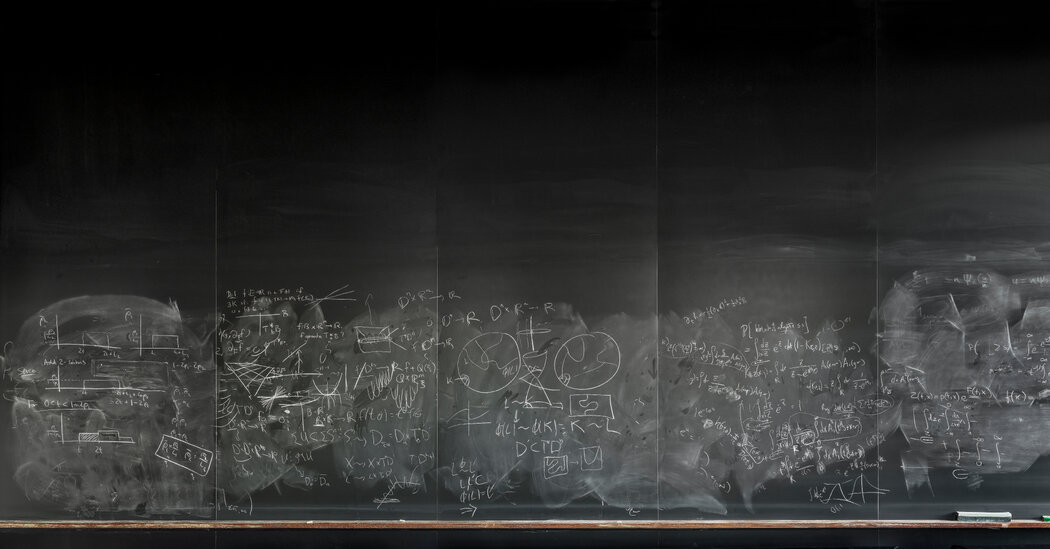PROOF: The Art and Science of Certainty, by Adam Kucharski
In June 1776, Thomas Jefferson sent a document to Benjamin Franklin, along with a note. “Will Doctr. Franklyn be so good as to peruse it,” Jefferson asked, “and suggest such alterations as his more enlarged view of the subject will dictate?” The document was most likely the Declaration of Independence, whose second paragraph began, “We hold these truths to be sacred & undeniable, that all men are created equal …” Franklin scratched out the words “sacred & undeniable” and replaced them with “self-evident.” A “sacred” truth implies a religious foundation; a “self-evident” one is a plain fact.
But as Adam Kucharski explains in his useful new book, “Proof: The Art and Science of Certainty,” it’s not as if Franklin’s edits immediately settled the matter. Chattel slavery would continue to be practiced for nearly a century. Abolitionists condemned slavery as a moral evil, but there was another kind of argument to be made against it, too. Abraham Lincoln, in a private note to himself in 1854, used a logical formula to convey the practice’s absurd contradictions: “If A can prove, however conclusively, that he may, of right, enslave B, why may not B snatch the same argument, and prove equally, that he may enslave A?”
Lincoln had been inspired by his close reading of Euclid, the ancient Greek mathematician who had proposed a set of fundamental principles for arriving at the truth. In debates, Lincoln would take care to define his terms as precisely as possible, striving to furnish “an agreed starting point” for discussion. He used logic both to understand what he believed to be true and to convince others of the same. He knew that proving something was a social act.
Kucharski, a mathematically trained epidemiologist, says that the rigor and purity of mathematics has imbued it with extraordinary rhetorical power. “In an uncertain world, it is reassuring to think there is at least one field that can provide definitive answers,” he writes. Yet he adds that certainty can sometimes be an illusion. “Even mathematical notions of proof” are “not always as robust and politics-free as they might seem.”
Historically, ironclad logic has also made “mathematical monsters.” In Zeno’s paradox, for instance, a tortoise gets a head start in a race with Achilles, who will never catch up to the tortoise if the race is defined in terms of the distance between them, which is infinitely divisible into ever smaller slices. Zeno went so far to suggest that motion itself was an illusion. Kucharski repeats the story (probably apocryphal) of Diogenes the Cynic getting so annoyed by Zeno’s claims that upon hearing them he stood up and walked away.
“Zeno’s riddles revealed a conflict between how objects moved according to mathematical theory and how motion worked in reality,” Kucharski writes, going on to show how generations of scientists have grappled with discrepancies between what a theory was telling them and what they could apprehend with their senses. Cultural preoccupations have shaped the realm of mathematical possibilities. At the same time that Euclid was developing his geometric proofs, mathematicians in China were writing about fortunes and debt. The Chinese consequently developed a concept of negative numbers — something that Europeans, whose mathematics was inspired by tangible objects, would shun for centuries. Kucharski quotes an 18th-century English mathematician who grumbled that negative numbers “darken the very whole doctrines of the equations and make dark of the things which are in their nature excessively obvious and simple.”
Needless to say, proving what is “obvious and simple” isn’t always easy. Kucharski offers the delightful example of Muriel Bristol, a scientist who always put the milk in her cup before pouring her tea, because she insisted it tasted better. In the 1920s, a skeptical statistician designed a blind taste test to see if Bristol could distinguish between cups of milk-then-tea and cups of tea-then-milk. Bristol got all of them right. In 2008, the Royal Society of Chemistry reported that when milk is poured into hot tea, “individual drops separate from the bulk of the milk” and allow “significant denaturation to occur.” The result is a burnt flavor. Eighty years after Bristol was statistically vindicated, she was chemically vindicated too.
Kucharski has his own reasons for writing about proof. Several years ago, he was one of the epidemiologists working on Britain’s response to the Covid pandemic. He started receiving abusive messages from people who didn’t want to believe his warnings about fatality risks and the importance of vaccines. As more data about the epidemic became publicly available, Kucharski assumed that it would become patently clear to people what was happening. He was mistaken. A few weeks into the first lockdown, his own wife told him that she had not really believed his predictions about the pandemic’s impact. “Despite all the evidence, and all our conversations, I hadn’t realized that I’d failed to convince her.”
Evidence, as it happens, isn’t always sufficient for persuading others. More fundamental are the underlying assumptions that we share — or don’t, as the case may be. Doubt can turn especially poisonous, “replacing a reality that can be agreed upon with one that is forever disputed,” Kucharski writes. Amid such a free-for-all, consensus, which is the foundation of social trust, begins to break down.
But sometimes the pretense of consensus can perpetuate attachment to an unjust status quo. In the United States, the unholy compromises with the Southern slave states in the antebellum era is a case in point. Two years into the Civil War, after the Battle of Gettysburg, Lincoln spoke of a nation “dedicated to the proposition that all men are created equal.” Kucharski notes this profound shift: Instead of assuming that equality was axiomatic and universally accepted, Lincoln chose to reframe it as a proposition. “The construction of the United States, he hoped, could be the proof.”
PROOF: The Art and Science of Certainty | By Adam Kucharski | Basic Books | 345 pp. | $32
